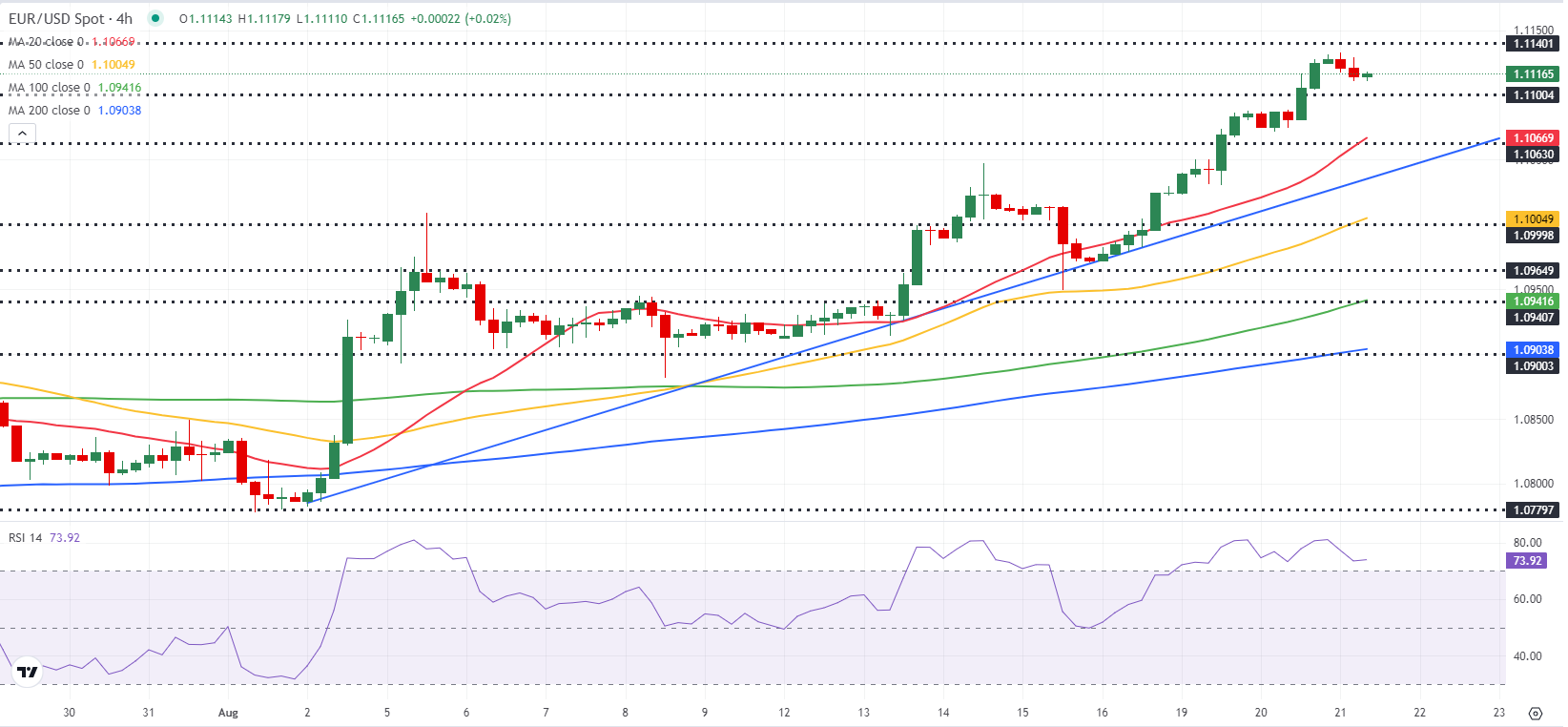- EUR/USD consolidates weekly gains above 1.1100 in the European session on Wednesday.
- Nonfarm Payrolls benchmark revision and FOMC Minutes could drive the USD's valuation.
- The pair remains technically overbought despite retreating from 2024 highs.
EUR/USD extended its winning streak into a third consecutive trading day on Tuesday and reached a 2024-high above 1.1130. The pair stages a correction early Wednesday but holds above 1.1100.
Euro FAQs
The Euro is the currency for the 20 European Union countries that belong to the Eurozone. It is the second most heavily traded currency in the world behind the US Dollar. In 2022, it accounted for 31% of all foreign exchange transactions, with an average daily turnover of over $2.2 trillion a day. EUR/USD is the most heavily traded currency pair in the world, accounting for an estimated 30% off all transactions, followed by EUR/JPY (4%), EUR/GBP (3%) and EUR/AUD (2%).
The European Central Bank (ECB) in Frankfurt, Germany, is the reserve bank for the Eurozone. The ECB sets interest rates and manages monetary policy. The ECB’s primary mandate is to maintain price stability, which means either controlling inflation or stimulating growth. Its primary tool is the raising or lowering of interest rates. Relatively high interest rates – or the expectation of higher rates – will usually benefit the Euro and vice versa. The ECB Governing Council makes monetary policy decisions at meetings held eight times a year. Decisions are made by heads of the Eurozone national banks and six permanent members, including the President of the ECB, Christine Lagarde.
Eurozone inflation data, measured by the Harmonized Index of Consumer Prices (HICP), is an important econometric for the Euro. If inflation rises more than expected, especially if above the ECB’s 2% target, it obliges the ECB to raise interest rates to bring it back under control. Relatively high interest rates compared to its counterparts will usually benefit the Euro, as it makes the region more attractive as a place for global investors to park their money.
Data releases gauge the health of the economy and can impact on the Euro. Indicators such as GDP, Manufacturing and Services PMIs, employment, and consumer sentiment surveys can all influence the direction of the single currency. A strong economy is good for the Euro. Not only does it attract more foreign investment but it may encourage the ECB to put up interest rates, which will directly strengthen the Euro. Otherwise, if economic data is weak, the Euro is likely to fall. Economic data for the four largest economies in the euro area (Germany, France, Italy and Spain) are especially significant, as they account for 75% of the Eurozone’s economy.
Another significant data release for the Euro is the Trade Balance. This indicator measures the difference between what a country earns from its exports and what it spends on imports over a given period. If a country produces highly sought after exports then its currency will gain in value purely from the extra demand created from foreign buyers seeking to purchase these goods. Therefore, a positive net Trade Balance strengthens a currency and vice versa for a negative balance.
The US Dollar (USD) failed to shake off the bearish pressure on Tuesday, pressured by falling US Treasury bond yields, and allowed EUR/USD to continue to push higher.
In the second half of the day, the US Bureau of Labor Statistics will release the preliminary estimate of the annual benchmark revision to the establishment survey employment series, which will show whether Nonfarm Payrolls in the 12 months to March were higher or lower than originally reported.
A significant downward revision could revive fears over a cooldown in the labor market and cause the USD to stay under pressure with the immediate reaction. On the other hand, an upward revision could have the opposite impact on the USD's valuation and trigger a downward correction in EUR/USD.
Later in the American session, the Federal Reserve will release the minutes of the July 30-31 policy meeting. Market participants will scrutinize discussions surrounding the policy easing strategy.
EUR/USD Technical Analysis
The Relative Strength Index (RSI) indicator on the 4-hour chart stays above 70 even though EUR/USD retreated slightly from the 2024-high, suggesting that the pair has more room on the downside for a correction before the next leg higher.
The immediate resistance is located at 1.1140 (static level). In case EUR/USD holds above this level and starts using it as support, it could target 1.1200 (psychological level, static level) next. On the downside, 1.1100 (psychological level, static level) aligns as immediate support ahead of 1.1060 (20-period Simple Moving Average (SMA), static level) and 1.1030 (ascending trend line).
Information on these pages contains forward-looking statements that involve risks and uncertainties. Markets and instruments profiled on this page are for informational purposes only and should not in any way come across as a recommendation to buy or sell in these assets. You should do your own thorough research before making any investment decisions. FXStreet does not in any way guarantee that this information is free from mistakes, errors, or material misstatements. It also does not guarantee that this information is of a timely nature. Investing in Open Markets involves a great deal of risk, including the loss of all or a portion of your investment, as well as emotional distress. All risks, losses and costs associated with investing, including total loss of principal, are your responsibility. The views and opinions expressed in this article are those of the authors and do not necessarily reflect the official policy or position of FXStreet nor its advertisers. The author will not be held responsible for information that is found at the end of links posted on this page.
If not otherwise explicitly mentioned in the body of the article, at the time of writing, the author has no position in any stock mentioned in this article and no business relationship with any company mentioned. The author has not received compensation for writing this article, other than from FXStreet.
FXStreet and the author do not provide personalized recommendations. The author makes no representations as to the accuracy, completeness, or suitability of this information. FXStreet and the author will not be liable for any errors, omissions or any losses, injuries or damages arising from this information and its display or use. Errors and omissions excepted.
The author and FXStreet are not registered investment advisors and nothing in this article is intended to be investment advice.
Recommended Content
Editors’ Picks

EUR/USD retreats toward 1.0850 despite weak US employment data
EUR/USD loses its traction and declines toward 1.0850 after testing 1.0900 earlier in the session. Because Nonfarm Payrolls data for October missed the market expectation by a wide margin due to hurricanes and strikes, the US Dollar manages to hold its ground.

GBP/USD climbs above 1.2950, looks to end week little changed
GBP/USD benefits from the improving risk mood and trades in positive territory above 1.2950 in the American session on Friday as markets ignore the weak labor market data from the US. The pair remains on track to end the week flat.

Gold clings to small gains near $2,750 after US data
Gold clings to marginal recovery gains and trades slightly above $2,750. The 10-year US Treasury bond yield struggles to push higher after the dismal October jobs report and weaker-than-expected PMI data from the US, helping XAU/USD keep it footing.

Bitcoin Weekly Forecast: Run toward fresh all-time high hinges on US presidential election results
Bitcoin could experience a price pullback in the next few days ahead of the US presidential election, analysts say, an event that will be key to determining whether and how the crypto class will be regulated in the years to come.

Bank of Japan holds rates steady amid signs of modest GDP growth
Monthly industrial production results have been mixed but generally indicate a modest recovery in third-quarter GDP. Clear guidance from the Bank of Japan remains elusive, with each upcoming meeting being pivotal.

Best Forex Brokers with Low Spreads
VERIFIED Low spreads are crucial for reducing trading costs. Explore top Forex brokers offering competitive spreads and high leverage. Compare options for EUR/USD, GBP/USD, USD/JPY, and Gold.
